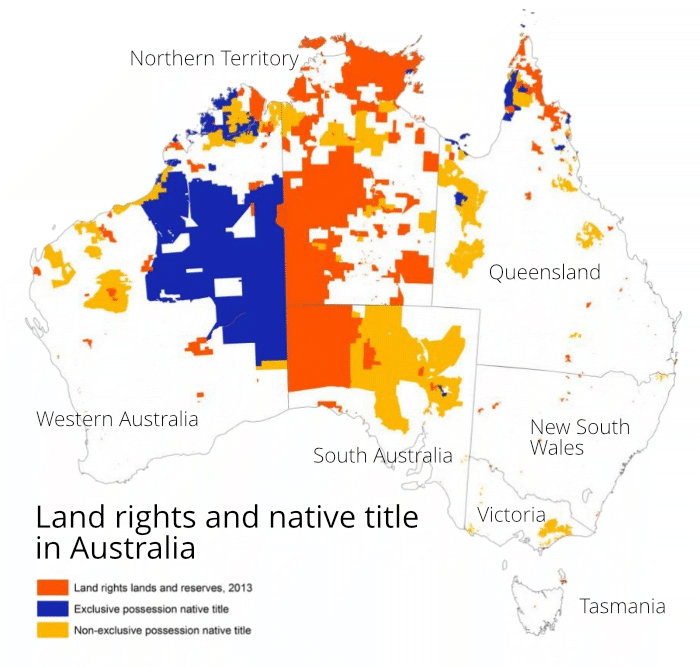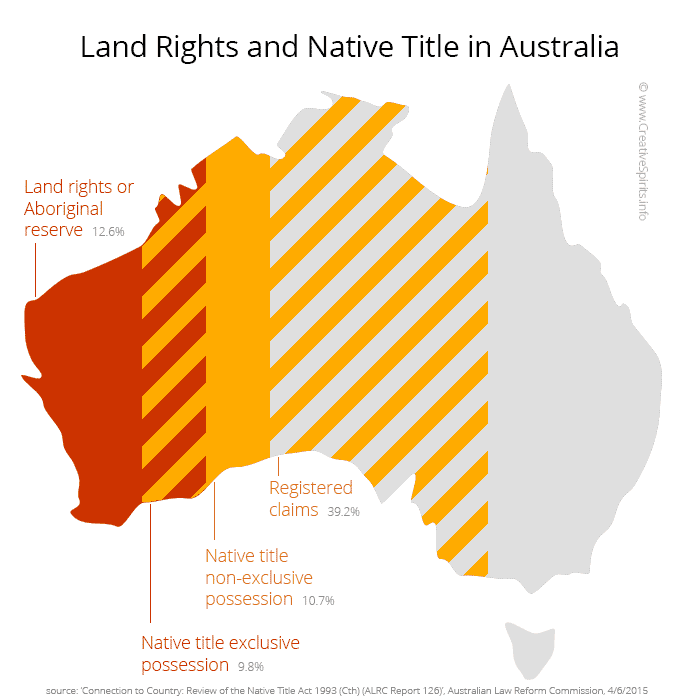Land
Land rights and native title – what's the difference?
Land rights and native title both formally recognise Aboriginal rights in land. But what is the difference between the two?

Wishing you knew more about Aboriginal culture? Search no more.
Get key foundational knowledge about Aboriginal culture in a fun and engaging way.
This is no ordinary resource: It includes a fictional story, quizzes, crosswords and even a treasure hunt.
Stop feeling bad about not knowing. Make it fun to know better.
Selected statistics
-
14.3% - Percentage of land in Australia that is Aboriginal land in 2002. [1]
- 44,300
- Approximate number of land rights claims made over available Crown Land since 1983. Proportion that is still undetermined: 73%. [2]
-
0.2% - Percentage of Victoria that is recognised as having land rights. [2]
Land rights and native title comparison
Both land rights and native title are a result of legislation by the Australian government. They help Aboriginal people to have their rights in land recognised. Both operate under different laws (or acts) and differ in the rights they can provide. [3]
| Land rights | Native title | |
|---|---|---|
| What is it? | The return of certain Crown lands to Aboriginal peoples as compensation for dispossession and the resulting ongoing disadvantage suffered by Aboriginal peoples. | The recognition of the pre-existing traditional and customary rights and interests Aboriginal peoples have in lands. |
| When was it introduced? | The NT Parliament passed the Aboriginal Land Rights (Northern Territory) Act 1976 (ALRA). The ALRA set out the functions and responsibilities of Aboriginal Land Councils which act as a lobby on land rights. Other states ratified similar legislation. [4] | Native title was first recognised by the courts in the 1992 Mabo decision. The Commonwealth then passed the Native Title Act 1993 (NTA) to put the decision into law. The Act applies to all of Australia. |
| Is traditional connection required? | No. Traditional connection does not need to be established for a land claim to be successful. The ALRA also allows to return culturally significant lands to people with a connection to that place. | Yes. Native title can only exist where Aboriginal people could prove to the Federal Court that they have maintained a continuing connection with an area via cultural practices, regular access and traditions. |
| Who can make a claim? | Aboriginal Land Councils constituted under the ALRA. | A native title claim group’s nominated representatives. This will usually be a group of people, not an individual. |
| Who determines the claim? | The government minister who applies the Crown Lands Act of the particular state or territory. | The Federal Court of Australia. |
| What land can successfully be claimed? | Crown lands that are not lawfully being used or occupied (as town, pastoral or private land is), not (likely) needed for residential or essential public purposes and not the subject of a registered native title claim or determination. | Vacant Crown land, National Parks, State Forests, Crown Reserves, some types of non-exclusive leases, land covered by permissive occupancies and licenses (e.g. towns, farms), inland waters and the sea. |
| Does it mean ownership? | Yes. Aboriginal people generally receive full or freehold title to land. This allows them to control entry to this land with permits. Sometimes land may be held in leasehold. | No. In most cases native title is recognised to co-exist alongside other rights and interests in the same area (non-exclusive possession). This can mean Aboriginal people can legally access and use the land for e.g. camping, hunting, fishing and other cultural activities. Only in some cases do they get rights akin to full ownership (exclusive possession). There is no right to control entry to this land. |
| Who holds the rights? | Aboriginal Land Councils recognised under the ALRA. | Either the native title holders or a Prescribed Body Corporate (PBC) holds the title in trust or as an agent. |
Note: Land rights and native title can co-exist under certain conditions on the same land.
This can cause problems when land councils want to develop the land they hold, for example erect a building. The land council hast to first clarify that native title doesn't exist on that land. If it does exist, the land council has to get an order extinguishing native title which can be lengthy land expensive, delaying any development. [5]
The two laws also mean that there can be two groups competing about who speaks for country and how to represent and advocate their interests, potentially creating conflict among Aboriginal stakeholders.
Video: Land rights and native title explained
Dr Heidi Norman, one of the ABC's humanities researchers, explains the difference between land rights and native title (90 secs).
Map of land rights and native title in Australia
The map below shows the distribution of land rights (in orange) and native title (in blue and yellow) in Australia in 2013. [6]

Land rights & native title percentage map
The map below shows the percentage of the Australian land mass that has been claimed by land rights (red), has been determined to be exclusive native title (red and yellow stripes), or non-exclusive native title (yellow) and the percentage that has been claimed but not determined yet (yellow stripes). [7]
